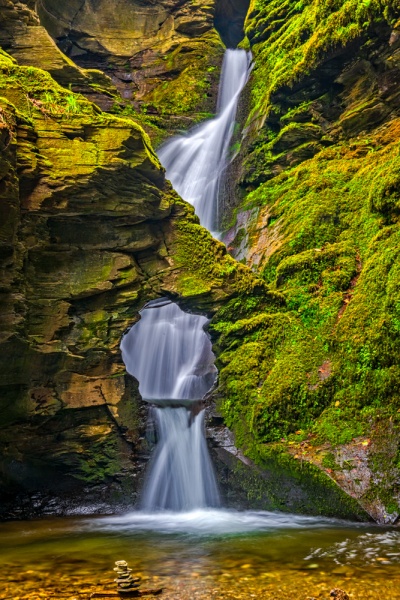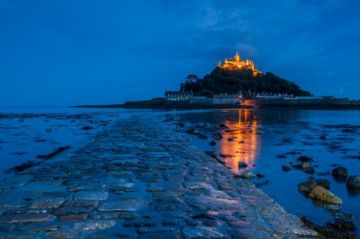
St Nectan's Glen has been called one of the most sacred sites in Britain; it is certainly one of the most beautiful and fascinating historic sites in Cornwall. At the top of the glen are a series of three waterfalls below the site of a hermitage established by the 6th-century Celtic saint Nectan. The hermitage and waterfalls can only be reached on foot after a mile-long walk beside the River Trevillet.
St Nectan's Glen has been named a Site of Special Scientific Interest (SSSI) in recognition of the wonderful array of rare plants growing along the wooded sides of the glen. The damp environment helps unusual species of liverwort and moss to flourish.

St Nectan
Nectan, or Nechtan, was one of 24 children of King Brychan of Brycheiniog (Brecknock) of Wales. Like all of Brychan's children, he was converted to Christianity, and decided to emulate St Anthony and become a hermit. Nectan and his companions set out from Wales, vowing to settle wherever their boat landed. The wind and tide brought him to the Hartland peninsula of North Devon, where he settled and was eventually martyred by robbers. After his death miracles were reported at his tomb.
Another version of the tale says that Nectan died here in Cornwall, some 30 miles south of Hartland, and he was buried under the waterfall along with a great treasure. Pilgrims have been following the trail up the glen to visit the site of Nectan's shrine since the early 6th century. A church, or chapel, was built on the site of Nectan's hermitage. A tale says that the chapel was once inhabited by a couple of witches, and local folk were quick to blame the witches for every bit of ill-fortune.
According to legend, Nectan established a hermitage in the Glen that now bears his name, inland from Rocky Valley, above the waterfall known as the Kieve. During storms the saint is said to have rung a silver bell at the mouth of Rocky Valley to warn ships of the dangerous rocks offshore. Local tales also say that The Hermitage residence stands atop an ancient Celtic chapel associated with St Nectan.

The Kieve
There are three waterfalls at the head of the Glen. The main falls are known as the Kieve, and drops some 60 feet before bursting through a circular hole in a rock and splashing into a shallow pool. The name 'Kieve' comes from the mining term for a wooden tub, or basin, used for extracting tin ore.
The force of the water has bored a hole through the solid Devonian slate, creating an unforgettable natural phenomenon. The waters of the Kieve are said to have healing qualities. Visitors have been coming here for centuries, leaving small personal objects, crystals, inscriptions, and more recently, photographs, and ribbons.
Just below the pool at the base of the Kieve is a second waterfall. This is more difficult to access, but you can get a good look from the footpath and bridge that runs beside the river. Starting in 2016 a third waterfall has been opened to visitors, accessed via a new extended walkway. This waterfall is some 80 feet in length, though less spectacular than the Kieve with its famous bore-hole. The third falls can only be reached via the extended walkway, for an additional fee.

The Hermitage
Above the Kieve is the Hermitage, built upon the site of the original hermit cell and chapel established by St Nectan. Cut into the rock face is a small chamber, thought to be where the saint would have prayed some 1500 years ago. It is still used as a quiet chapel for personal reflection and prayer. The building that now houses the hermit cell dates to the 1860s, but it incorporates an early Christian chapel in the lower part of its walls.
St Pirans Church & Holy Well
At the start of the walk leading to the glen is a holy well linked to stories of St Piran, a 5th century missionary. Just above the well is St Pirans church, dating to at least 1497. By the side of the trail to the Glen, just past St Piran's church, is an old Roman milestone, discovered in 1919 being used as a gatepost.

Visiting
The only way to visit the Hermitage and enjoy the waterfalls and glen is on foot. There is a signposted parking area on the west side of the B3266 between Boscastle and Tintagel. Coming north from Boscastle the parking area is at the crest of the hill coming into Trethevy. It comes into view rather abruptly, so take care as you come up the hill.
From the parking area, cross the road, taking the signed trail up the lane and turn right through the gate in front of St Pirans Chapel. The trail leads down into the wooded glen and runs along the course of the river, and crossing over a footbridge, before climbing to the Kieve and hermitage. The walk is about a mile in length and will take at least 20-30 minutes, or longer if you pause to enjoy the wonderful scenic gorge. The going can be wet and muddy in places, especially after rainy periods.
The best way to enjoy the waterfalls is to walk right into the pool below the lower falls. The visiting centre has rubber boots available for adults and children, as part of the admission fee. You do not need rubber boots to visit the Hermitage. From the visitor centre, you can opt to descend directly to the waterfall, or follow a longer route that takes a wooden footbridge and walkway to the far side of the gorge for excellent views over the falls from above and from both sides.
The walkway then descends in stages to the bottom waterfall and from there you can walk into the shallow pool at the base of the falls or rest on a handy bench and just listen to the sound of the water. You'll notice that visitors have left small offerings and memorials around the stone walls carved out b the action of the waterfalls. There are poignant plaques to loved ones, colourful ribbons, and both Christian and pagan symbolic offerings.
The visitor centre has a lovely shop and tea room on a terrace over the waterfalls.
I've been fortunate to visit the Glen several times. This is truly a magical place, a special place, a place where time seems to stand still and you want to linger.

About St Nectan's Glen
Address: Rocky Valley,
Trethevy,
Cornwall,
England, PL34 0BG
Attraction Type: Prehistoric Site - Early Christian site
Location: Access by footpath only from a parking area at Trethevy, on the B3266 between Boscastle and Tintagel
Website: St Nectan's Glen
Email: info@st-nectansglen.co.uk
Location
map
OS: SX081885
Photo Credit: David Ross and Britain Express
NEARBY HISTORIC ATTRACTIONS
Heritage Rated from 1- 5 (low to exceptional) on historic interest
Trethevy, St Piran's Chapel and Holy Well - 0.5 miles (Historic Church) ![]()
Rocky Valley Labyrinths - 0.7 miles (Prehistoric Site) ![]()
Trevalga, St Petroc's Church - 0.9 miles (Historic Church) ![]()
Tintagel Old Post Office - 1.5 miles (Historic Building) ![]()
King Arthurs Great Halls - 1.6 miles (Historic Building) ![]()
Forrabury Church & Cross - 1.7 miles (Historic Church) ![]()
Willapark and Forrabury Stitches - 1.8 miles (Countryside) ![]()
Tintagel Castle - 1.8 miles (Castle) ![]()














